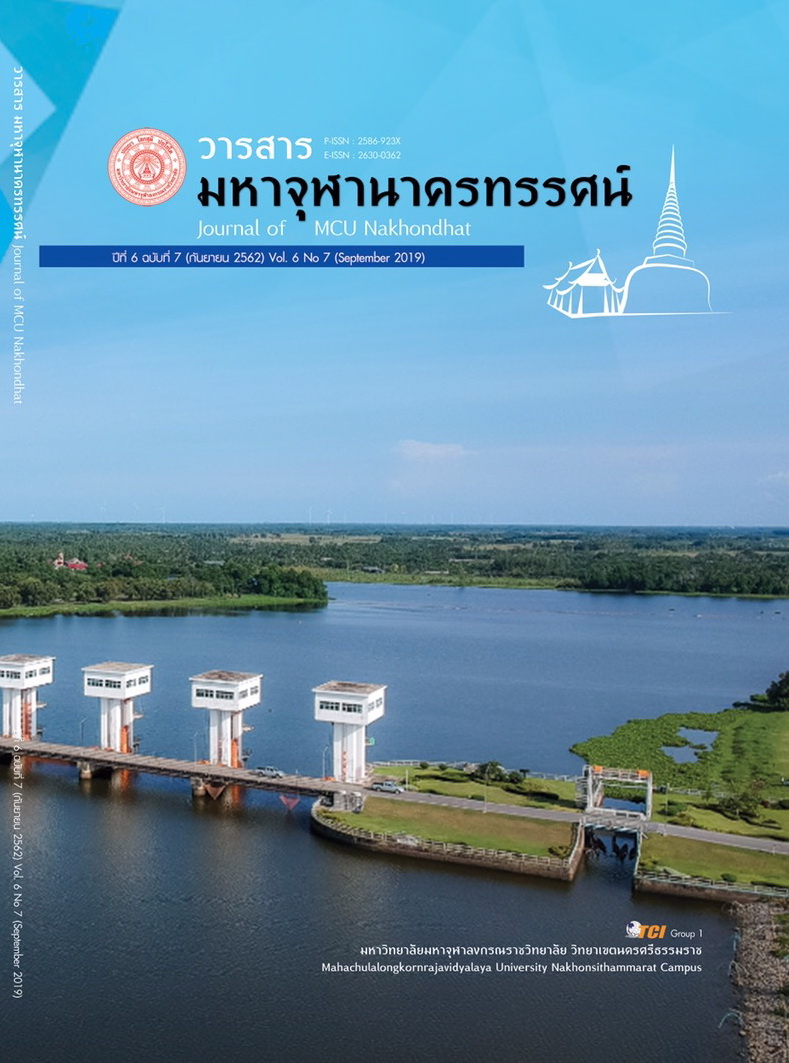AN ANALYTICAL STUDY ON THE BUDDHIST DOCTRINE EMBEDED IN ARCHITECTURES OF LANNA TEMPLES
Main Article Content
Abstract
The objectives of this research were to study the architecture of temples from 9 Lanna temples and to analyze Buddhist ethics were kept hidden in the architecture of Lanna Temples. This is Qualitative research was collected data from the related researches, and in-depth interview to the relevant person to get more information; after that data analysis would be descriptive text.
The results indicated that
The architecture is the art of designing buildings in general. Buddhist architecture is the religious architecture which is called temples, especially Buddhist architecture that has Buddhist ethics; it is Words of the Buddha was kept hidden on it. Lanna architecture is Lanna’s art-works of building construction in dark ages 200 years ago during under political power of Myanmar. Lanna had tried to a reconstruction of cities until in the period time of Lord Kawila was the renaissance of art and culture, luckily there was some of the archaeological evidence in the ages. In early ages, the evidence was lost, and later time, the Lanna kingdom was unified to Siam. Consequently, the architecture history in each age has a different story, and also Buddhist ethics was hide in the pagoda, and the sanctuary; there were 2 types of worship, the first one ār-mis̄ būchā, and the bpà-dtì-bàt būchā of 31 poom or dtrai poom. It is Buddhist literature that mentioned to 3 planes were Sensuous Planes 11, Form Planes 16, and Formless Planes 4. Next one was Buddhist ethics was hide in sanctuary of Lanna temples were Ariyasacca the Noble Truth; (Cattàri Ariyasaccàni) the Four Noble Truths. it is human nature in during lifetime have to endure physical suffering such as pain, sickness, injury, tiredness, old age, and eventually death, and (Dasapàramã) the ten perfections; the ten principal virtues practised by a Bodhisatta.
Article Details
References
พระมหาไพบูลย์ วิปุโล (เลิศฤทธิ์ธนกุล). (2551). “การศึกษาแนวคิดเกี่ยวกับเสนาสนะในพระพุทธศาสนา". ใน วิทยานิพนธ์พุทธศาสตรมหาบัณฑิต สาขาวิชาพระพุทธศาสนา. มหาวิทยาลัยมหาจุฬาลงกรณราชวิทยาลัย.
มจ. อิทธิเทพสรรค์ กฤดากร. (2538). เรื่องเกี่ยวกับสถาปัตยกรรม. (พิมพ์ครั้งที่ 1). กรุงเทพมหานคร : โรงพิมพ์พระจันทร์.
มหาจุฬาลงกรณราชวิทยาลัย. (2539). พระไตรปิฎก ภาษาไทย ฉบับมหาจุฬาลงกรณราชวิทยาลัย. กรุงเทพมหานคร: โรงพิมพ์มหาจุฬาลงกรณราชวิทยาลัย.
มัย ตะติยะ. (2555). สุนทรียภาพทางทัศนศิลป์. (พิมพ์ครั้งที่ 3). กรุงเทพมหานคร: มิตรสัมพันธ์กราฟฟิค.
วรลัญจก์ บุณยสุรัตน์. (2544). วิหารล้านนา. (พิมพ์ครั้งที่ 1). กรุงเทพมหานคร: เมืองโบราณ.
วิฑูรย์ เหลียวรุ่งเรือง. (2543). สถาปัตยกรรมเชียงใหม่. (พิมพ์ครั้งที่ 1). เชียงใหม่: สำนักส่งเสริมศิลปวัฒนธรรม มหาวิทยาลัยเชียงใหม่.
วิบูลย์ ลี้สุวรรณ. (2547). ทัศนศิลป์ไทย. (พิมพ์ครั้งที่ 1). กรุงเทพมหานคร: ชมรมเด็ก.
ศักดิ์ชัย สายสิงห์. (2548). ศิลปะทวารวดี : วัฒนธรรมพุทธศาสนายุคแรกเริ่มในดินแดนไทย. (พิมพ์ครั้งที่ 5). นนทบุรี: เมืองโบราณ.
สดี ทิพทัส. (2551). เกณฑ์ในการออกแบบสถาปัตยกรรม. (พิมพ์ครั้งที่ 2). กรุงเทพมหานคร: จุฬาลงกรณ์มหาวิทยาลัย.
สันติ เล็กสุขุม. (2538). ศิลปะภาคเหนือ : หริภุญไชย–ล้านนา. (พิมพ์ครั้งที่ 2). นนทบุรี: เมืองโบราณ.
สันติ เล็กสุขุม. (2538). “หริภุญไชย-ล้านนา ศิลปะภาคเหนือ”. (พิมพ์ครั้งที่ 1). นนทบุรี: เมืองโบราณ.
สุรพล ดำริห์กุล. (2547). ประวัติศาสตร์และศิลปะหริภุญไชย. (พิมพ์ครั้งที่ 3). นนทบุรี: เมืองโบราณ.
สุรพล ดำริห์กุล. (2561). ประวัติศาสตร์และศิลปะล้านนา. (พิมพ์ครั้งที่ 1). นนทบุรี: เมืองโบราณ.
สุรัสวดี อ๋องสกุล. (2539). ประวัติศาสตร์ล้านนา. (พิมพ์ครั้งที่ 2). กรุงเทพมหานคร: อัมรินทร์พริ้นติ้งแอนด์พับลิชชิ่ง จำกัด.
เสนอ นิลเดช. (2538). ประวัติศาสตร์สถาปัตยกรรมไทย. (พิมพ์ครั้งที่ 2). กรุงเทพมหานคร: โรงพิมพ์มหาวิทยาลัยธรรมศาสตร์.
อำพร มาลัย. (2540). “การศึกษาวิหารล้านนาในสมัยปกครองเชื้อสายตระกูลเจ้าเจ็ดตน พ.ศ. 2317-2442 ในจังหวัดเชียงใหม่ ลำปาง ลำพูน”. ใน วิทยานิพนธ์ศิลปศาสตรมหาบัณฑิต สาขาวิชาประวัติศาสตร์ สถาปัตยกรรม . มหาวิทยาลัยศิลปากร.


